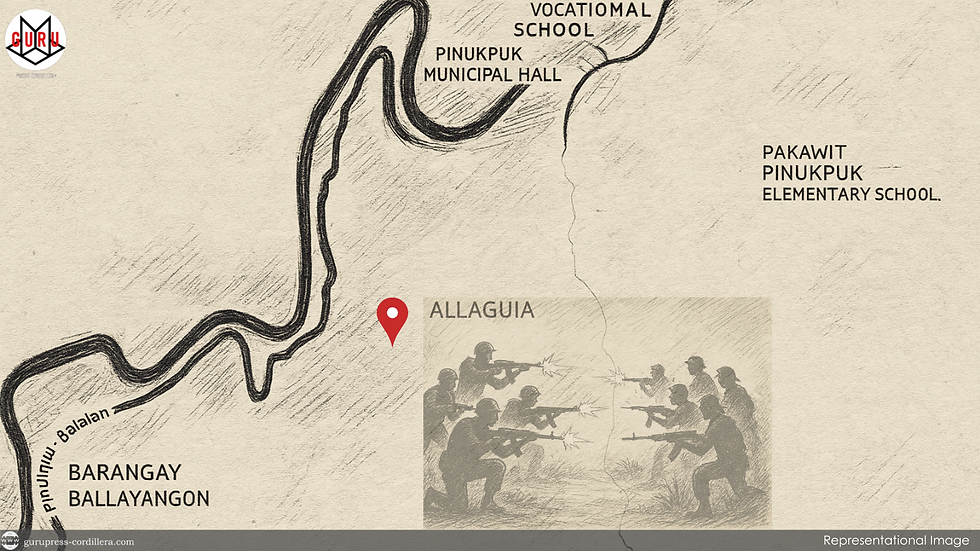Tinglayan tribal leaders call on Butbut and Betwagan tribes to extend ceasefire agreement
Tinglayan, Kalinga – Ahead of the expiration of the two-month truce between the Butbut and Betwagan tribes, the elders and tribal leaders of Tinglayan are calling on both parties to extend their Cease-and-Desist Agreement made on September 27, 2025. The appeal was issued through Resolution No. 01 s. 2025, which the Office of the Municipal Peace Corps of Tinglayan submitted and approved on November 26. The two-month truce between the Butbut tribe of Tinglayan, Kalinga, and t

Leonora Lo-oy
1 hour ago1 min read


Santa Marcela LGU delivers immediate aid to two flooded barangays as town suffers from heavy rains
Santa Marcela, Apayao - The Municipal Government Unti of Santa Marcela under Mayor Evelyn B. Martinez responded quickly to the two flooded barangays in town, providing 120 food packs to aid affected families. The town of Santa Marcela is one of the lowlying municipalities in Apayao Province and whose territory is part of the mighty Apayao-Abulug River. Due to the heavy rains brought by the shearline affecting Luzon, Barangay Consuelo and San Juan, flood prone areas, experien
Santa Marcela LGU
6 hours ago1 min read


‘Only one fire incident monitored from Oct. – Nov. 2025; sana dina madagdagan’ - BFP-Kalinga
Tabuk City, Kalinga – The Bureau of Fire Protection Kalinga documented only one fire incident in the province from October to November this year, a significant decrease in cases when compared to the same period last year with five cases. “Last year we have 5 cases from October to November. Now, we have just one… sana dina madagdagan,” said SFO2 Victor M Dail, Chief of Operations Section, adding that the fire incident documented in the past two months was a structural fire. D
Mark Jordan Bomogao
6 hours ago1 min read


“I instructed…to make sure that the slain rebel be given a decent burial… Makipakaasiak nga bumaba kayon (NPAs) ta adda met isabat mi nga pagrugian yo…” – Governor Edduba
Tabuk City, Kalinga – Following the gunfights that happened between the government troops and the rebels in Allaguia, Piunkpuk that resulted in the killing of one of the cadres, Governor James Edduba instructed the provincial government to make sure the slain rebel on November 23 is given a decent burial. The deceased who was identified as Victor Madalang Daligdig of Sitio Anunang, Liwan West, Rizal was killed in the second of the six gunfights between the members of the Il

Leonora Lo-oy
7 hours ago2 min read


‘Nu haan ammu i-manage, adda certainty for complications…’ – Dr. Aranca on importance of raising awareness on Epilepsy, recalling he was epileptic
Tabuk City, Kalinga – Drawing from his own childhood experiences, Kalinga Provincial Hospital OIC-Chief, Dr. Rey Aranca, emphasized the crucial importance of being informed about epilepsy and knowing how to properly manage it to avoid complications. Aranca made the statement during the First Epilepsy Camp initiated by KPH on November 22 at the Kalinga Children’s Conference Hall. The event aimed to empower parents and guardians of patients living with epilepsy. Speaking before

Leonora Lo-oy
10 hours ago2 min read


High-powered guns recovered from military–NPA clash in Pinukpuk, Kalinga – 103rd Infantry Battalion
Pinukpuk, Kalinga – Fleeing members of the Ilocos Cordillera Regional Committee (ICRC) left behind several of their high-powered firearms as they escaped from the military following a series of clashes in Pinukpuk, the 103rd Infantry Battalion reported on November 25. According to the battalion’s report posted on its media channel, the military recovered various war materials, firearms, and ammunition from the group during five separate encounters in Allaguia, Pinukpuk since

Leonora Lo-oy
10 hours ago1 min read


BM Kitongan pushes for increase in mortuary aid for provincial gov’t workers in Kalinga who die on duty during disasters or calamities from P10,000 to P25,000
Tabuk City, Kalinga – To ease the burden on families of provincial government workers who may lose their lives while performing their duties during calamities, Kalinga Board Member Emilio T. Kitongan has pushed for the amendment of the province’s existing mortuary aid ordinance, raising the amount of financial assistance and expanding its coverage. Currently, families of provincial government workers who die in the performance of their duties receive P10,000, as provided unde

Mark Moises Calayan
10 hours ago2 min read


‘Haan umanay diay 300 hectares nga area para dagitoy endangered species… we leave it to Dacalan—we respect your decisions’ – BM Lammawin on the proposal of DENR for a Critical Habitat in Tanudan
Tabuk City, Kalinga – Provincial Board Member Camilo T. Lammawin raised concerns over the Department of Environment and Natural Resources’ (DENR) proposal to designate a 300-hectare Critical Habitat in Tanudan, particularly in Barangay Dacalan, stressing that the area is insufficient to protect endangered species but said the final decision rests with the Dacalan delegation, and that he fully respects it. Lammawin made this statement at the regular session of the Sangguniang

Lorraine Bacullo
10 hours ago2 min read


‘Tatta nga maudi nga biyag na sa mi makita isuna’ – Relative of rebel killed in Allaguia clash says they hadn’t seen him since 2007
Pinukpuk, Kalinga – Relatives of the slain New People’s Army (NPA) cadre in the Allaguia clash on Sunday mourned as they reunited with his remains after not seeing him since he left to join the movement nearly two decades ago. The said cadre was the casualty in the ongoing pursuit operations against members of the Ilocos Cordillera Regional Committee (ICRC), following the first gunfight between the military and the group on November 21 in Bayao, Pinukpuk. The rebel, whose ide

Leonora Lo-oy
1 day ago2 min read


27-year-old man in Isabela ends life; debts and farm losses believed to be the cause
Santiago City, Isabela – A 27-year-old farmer in Santiago City, Isabela, ended his life on Saturday, November 22, 2025, with initial investigations indicating that he had been struggling with overwhelming personal problems. According to a police report obtained by XFM-Santiago, the victim’s grandmother saw him holding a bolo before the incident occurred. When she asked what he intended to do with it, he did not respond and suddenly cut himself in the neck. In shock, the grand

Mark Moises Calayan
1 day ago1 min read


Banaue, Ifugao temporarily suspends trekking and hiking activities after widespread destruction brought by Super Typhoon Uwan
Banaue, Ifugao – Visitors to Banaue are urged to avoid outdoor tourist sites as the municipal government has suspended such activities for safety purposes following the widespread destruction caused by Super Typhoon Uwan, leaving at least five people dead. The typhoon also left the town with damaged houses, stores, and vehicles as well as public utilities, mostly destroyed by mudslides and flash floods. Banaue also experienced severe disruption of power and water services. In

Mark Moises Calayan
1 day ago2 min read


P3.2M livelihood packages awarded to fisherfolk in CAR; “Hangga’t hindi pa sila naggagraduate within the span of six years, SAAD will support them” – SAAD Program Coordinator Michelle Peralta
Tabuk City, Kalinga – To help beneficiaries grow their community-based enterprises, the Bureau of Fisheries and Aquatic Resources (BFAR)-Cordillera recently awarded over P3 million worth of livelihood packages to fisherfolk in the region. The assistance was granted to organized fisherfolk groups from the Apayao, Ifugao, Mountain Province, and Kalinga clusters, whose businesses are being supported under Phase 2 of the Special Area for Agricultural Development (SAAD) program of

Mark Moises Calayan
1 day ago2 min read


First Cordilleran working with astronauts eyes space-powered climate solutions for Kalinga
Tabuk City, Kalinga - Gwendolyn Pascua, who hails from Kalinga and Mt. Province and the first female Cordilleran to work alongside astronauts as a Ground Controller at Biotechnology Space Support Center (BIOTESC) in Switzerland, visited the Provincial Government of Kalinga on November 24, 2025 and proposed the use of space-based technologies in identifying climate-risk areas and guiding infrastructure planning across the province. Pascua met with Acting Governor and Vice Gove

Lorraine Bacullo
1 day ago2 min read


“Hinabol-habol namin (rebels) sila hanggang nacorner na…” – Lt. Col. Obias (103rd Infantry Mabalasik Battalion) following fourth armed encounter in Pinukpuk, Kalinga
Pinukpuk, Kalinga – Lt. Colonel Jimric Obias, Battalion Commander of the 103rd Infantry “Mabalasik” Battalion, said in a separate interview with Guru Press Cordillera today, November 24, 2025, that they will not stop their pursuit operations against members of the Communist Terrorist Group (CTG) following the first gunfight between government troops and rebels on November 22. The latest armed encounter happened again in Allaguia, Pinukpuk today, November 24, marking the fou

Leonora Lo-oy
2 days ago2 min read


‘Narigat ti addaan anak nga epileptic… makasangit ka ag-seizure attack. Agyaman kami KPH ti tulong ditoy FIRST Epilepsy Camp’ - Parent of epileptic child
Tabuk City, Kalinga – To empower parents and guardians of children living with epilepsy to better manage the condition, the Kalinga Provincial Hospital (KPH) held its first-ever Epilepsy Camp on November 22 at the Kalinga Children’s Conference Hall and Wellness Center in Bulanao—equipping participants with essential knowledge on the nature of the disease and how to properly respond to seizures. Epilepsy, as defined by the World Health Organization, is a chronic noncommunicabl

Leonora Lo-oy
2 days ago2 min read

.png)












%20(2).png)


























































Comments